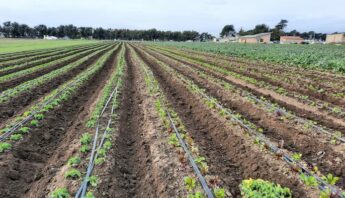In these troubled times I’m eager to find rays of hope. In the world of food and farming, one such glimmer is the growing recognition by gardeners and farmers, consumers and politicians that healthy soil is essential to our community and planetary well-being.
This post is part two in our “Science for Solutions” blog series that amplifies scientist voices and underscores the importance of independent science as the foundation for evidence-based policymaking and narrative shifts.
In these troubled times I’m eager to find rays of hope. In the world of food and farming, one such glimmer is the growing recognition by gardeners and farmers, consumers and politicians that healthy soil is essential to our community and planetary well-being.
Healthy soils produce healthy, abundant crops. They also make farms more resilient in the face of the increasingly frequent and intense problems of flooding, drought and temperature swings associated with climate change.
Healthy soils and the practices that build them can also contribute to turning climate change around, by reducing emissions of greenhouse gases (i.e. nitrous oxide and methane) and by capturing carbon dioxide in plants, soil organic matter, soil microbes and other living organisms.
Lessons from the Dust Bowl
Soil science has been a fundamental influencer of agriculture policy in the U.S. since at least the 1930s when, in response to the devastating U.S. Dust Bowl, the federal government established the predecessor of what is now the Natural Resources Conservation Service (NRCS). Back then, a focus was using data on physical characteristics of soil and how best to prevent soil erosion from wind and water..
Under today’s industrialized farming practices, soil losses continue to exceed the rate at which soil is formed. The resulting impacts include the reduced capacity to support crop production along with contamination of air, water and communities with pesticides and fertilizers.
As our understanding of the impacts of conventional agriculture has grown, so too has the science of solutions, with soil health as the foundation. The National Sustainable Agriculture Coalition (NSAC) recently stated it this way:
“Because of the strong positive impacts that healthy soil can have (e.g., sustaining plant and animal life, reducing environmental impacts like erosion and runoff, mitigating the effects of climate change and increasing yields) farmers have increasingly sought opportunities for soil quality enhancement on their operations.”
Some of the best stories of the science and successes of soil conservation can be found in the online Secrets of the Soil series from NRCS. Agency staff also bring soil science updates to farmers through in-state outreach and technical assistance and to farmers and layfolk for free through regular webinars.
Key policy frameworks are right on!
The challenge is convincing policymakers that the policies needed to protect and build soil health are good investments of taxpayers’ dollars. Since government funding is a challenge (especially now), we need to make the benefits of spending public money to support soil-protective practices — rather than “conventional” soil-destructive practices, inclluding heavy use of pesticides and fertilizers — crystal clear.
And we’re making progress. In 2015, scientists, farmers and policymakers celebrated the international year of soils, demonstrating global recognition of the great importance of protecting soils and their capacity to support food production, ensure global food security, and deliver myriad ecosystem services.
In December 2016, near the end of the Obama administration, the U.S. government produced a compelling framework document The State and Future of U.S. Soils: Framework for a Federal Strategic Plan for Soil Science. The report called for maintaining — and ramping up — long-standing policies promoting soil conservation on agricultural lands. It warned that failure to focus on soil health would leave us “vulnerable to severe soil degradation,” and reduce “resilience against the effects of a changing climate.”
Encouragingly, the report recommends establishing “a whole-of-government approach for interagency coordination and collaboration on soil research, conservation, and restoration priorities.”
Farm Bill conservation funds in demand
The U.S. Farm Bill, a multi-billion-dollar set of national policies reauthorized by Congress about every five years, addresses virtually every part of our food and farm system. The 2014 Farm Bill is up for renewal next year, so now is the time to ensure that this massive piece of legislation supports resilient, productive farming and protects farming communities and vital natural resources. Fundamental to all these objectives is soil health.
Two key programs directly support healthy soils — the Conservation Stewardship Program (CSP) and the Environmental Quality Incentives Program (EQIP). Through these programs farmers recieve incentives for soil-protective practices such as use of cover crops, diversified crop rotations, high-level rotational grazing or even agroforesty systems.
In 2016 more than a million acres were planted to cover crops with one or more of the following elements that build soil health: plant diversity, deeply rooted plants, annual grasses to scavenge soil nitrogen, production of residues to suppress weeds and add organic matter and nitrogen-adding legumes. Crop rotations help improve soil health, reduce soil erosion, and improve soil moisture efficiency.
More healthy soil, please
We’ll continue to work closely with our partners across the country to expand the support of farming practices that build soil health. We’ll also be arguing for “conservation compliance,” a requirement that farmers must use risk-reducing conservation practices to qualify for crop subsidies and other government support.
The Food and Farm Bill (as it should be named) can move us toward the sustainable, equitable food system this country so desparately needs — with healthy soils a key part of the solution. But Farm Bill negotiations are highly political, and it’ll take a strong, diverse and united movement to get us where we need to go. Core principles and priorities are laid out clearly by our partners at NSAC and by the HEAL Food Alliance; PAN is an active member of both of these national coalitions.
So, stay tuned for opportunities to support our allies in Congress, and encourage should-be allies to fight for food and farm policy that promotes healthy soils and sustainable practices while supporting diverse farm communities and ensuring access to healthy foods for all.
Read about toxic chemicals and kids’ brains from the Science for Solutions series.







